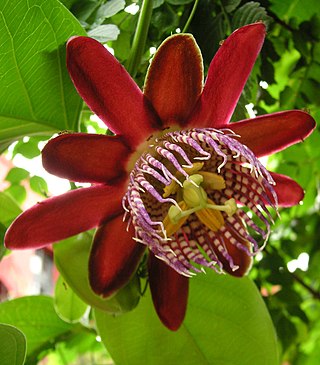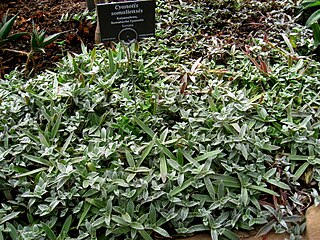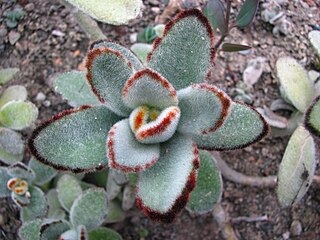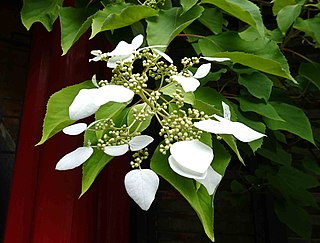
The Royal Horticultural Society (RHS), founded in 1804 as the Horticultural Society of London, is the UK's leading gardening charity.

Tradescantia is a genus of 85 species of herbaceous perennial wildflowers in the family Commelinaceae, native to the Americas from southern Canada to northern Argentina, including the West Indies. Members of the genus are known by many common names, including inchplant, wandering jew, spiderwort, dayflower and trad.

Cytisus is a genus of flowering plants in the family Fabaceae, native to open sites in Europe, western Asia and North Africa. It belongs to the subfamily Faboideae, and is one of several genera in the tribe Genisteae which are commonly called brooms. They are shrubs producing masses of brightly coloured, pea-like flowers, often highly fragrant. Members of the segregate genera Calicotome, Chamaecytisus, and Lembotropis are sometimes included in Cytisus.

Macleaya, or plume poppy, is a genus of two or three species of flowering plants in the poppy family Papaveraceae, native to Japan and China. They are large rhizomatous herbaceous perennials with palmately lobed, frilly leaves of olive green or grey colour, 25 cm (10 in) long, and tall stems with airy plumes of petal-less, tubular, off-white or cream flowers.

Euonymus fortunei, the spindle, Fortune's spindle, winter creeper or wintercreeper, is a species of flowering plant in the family Celastraceae, native to east Asia, including China, Korea, the Philippines and Japan. E. fortunei is highly invasive and damaging in the United States, causing the death of trees and forest in urban areas.

Passiflora alata, the winged-stem passion flower, is a species of flowering plant. It is an evergreen vine, growing to 6 m (20 ft) or more, which bears an edible type of passion fruit. It is native to the Amazon, from Peru to eastern Brazil.

Cyanotis is a genus of mainly perennial plants in the family Commelinaceae, first described in 1825. It is native to Africa, southern Asia, and northern Australia.
Hortus Kewensis, or a Catalogue of the Plants Cultivated in the Royal Botanic Garden at Kew by William Aiton was a 1789 catalogue of all the plant species then in cultivation at the Royal Botanic Gardens, Kew, which constituted the vast majority of plant species in cultivation in all of England. It included information on the country of origin, who introduced the plant into English cultivation, and when. It is therefore now one of the most important sources of information on history of horticulture in England.
David Richard Hunt was an English botanist and taxonomist. He was a specialist in cacti and the spiderwort family. He notably compiled the 1999 CITES Cactaceae Checklist.

Belosynapsis kewensis is a monocotyledonous plant in the dayflower family. The plant occurs in the far south of India in the Western Ghats. It is considered endangered or possibly extinct in the Indian state of Tamil Nadu, where it occurs only in the southern districts of Tinnevelly and Kanyakumari. It may be synonymous with Cyanotis beddomei.

Tradescantia spathacea, the oyster plant, boatlily or Moses-in-the-cradle, is a herb in the Commelinaceae family first described in 1788. It is native to Belize, Guatemala, and southern Mexico but widely cultivated as an ornamental and naturalized in parts of Florida, Texas, Hawaii, and various oceanic islands.

Clematis alpina, the Alpine clematis, is a flowering deciduous vine of the genus Clematis. Like many members of that genus, it is prized by gardeners for its showy flowers. It bears 1 to 3-inch spring flowers on long stalks in a wide variety of colors. C. alpina is native to Europe; in the United States it grows best in American Horticultural Society zones 9 to 6, which are generally found in the southern USA.

Cyanotis somaliensis, pussy ears, is a species of flowering plant in the family Commelinaceae, described in 1895. It is endemic to Somaliland in East Africa. Growing to 12 cm (4.7 in) tall by 50 cm (20 in) broad, it is an evergreen perennial with hairy, slightly succulent leaves and, in summer, three-lobed blue or purple flowers which resemble those of Tradescantia, a closely related genus.

Coleotrype is a genus of perennial monocotyledonous flowering plants in the dayflower family. It is found in Africa and Madagascar.

Amischotolype is a genus of perennial monocotyledonous flowering plants in the Commelinaceae. It is found in Central Africa and from India through Southeast Asia to New Guinea, with the great majority or species found in Asia.

Kalanchoe tomentosa, also known as pussy ears or panda plant, is a succulent plant in the genus Kalanchoe. A native of Madagascar, Kalanchoe tomentosa has many different cultivars such as 'Chocolate Soldier', 'Golden Girl', 'Black Tie' and 'Teddy Bear'. It has red-rimmed leaves.

Belosynapsis is a genus of mainly perennial plants in the family Commelinaceae, first described in 1871. It is native to Southeast Asia, the Indian Subcontinent, Papuasia, and southern China.

Callisia navicularis is a species of flowering plant in the family Commelinaceae. It has gained the Royal Horticultural Society's Award of Garden Merit as a warm temperate greenhouse ornamental.

Peperomia serpens, the vining peperomia, is a species of flowering plant in the genus Peperomia and family Piperaceae, native to the New World Tropics. The plant is perennial.

Hydrangea hydrangeoides, the Japanese hydrangea vine, is a species of flowering plant in the family Hydrangeaceae, native to Ulleungdo Island of South Korea, Japan, and the southern Kuril Islands.

















